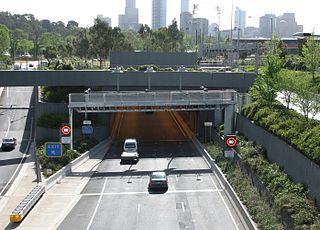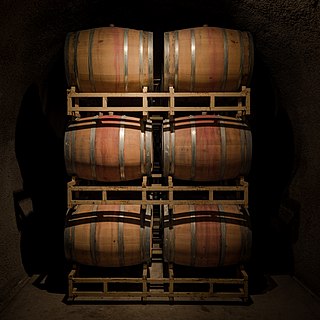
A tunnel is an underground passageway, dug through surrounding soil, earth or rock, and enclosed except for the entrance and exit, commonly at each end. A pipeline is not a tunnel, though some recent tunnels have used immersed tube construction techniques rather than traditional tunnel boring methods.

A tunnelling shield is a protective structure used during the excavation of large, man-made tunnels. When excavating through ground that is soft, liquid, or otherwise unstable, there is a potential health and safety hazard to workers and the project itself from falling materials or a cave-in. A tunnelling shield can be used as a temporary support structure. It is usually in place for the short-term from when the tunnel section is excavated until it can be lined with a permanent support structure. The permanent structure may be made up of, depending on the period, bricks, concrete, cast iron, or steel. Although modern shields are commonly cylindrical, the first "shield", designed by Marc Isambard Brunel, was actually a large, rectangular, scaffold-like iron structure with three levels and twelve sections per level, with a solid load-bearing top surface. The structure protected the men from cave-ins as they laboured within it, digging the tunnel out in front of the shield.

Excavators are heavy construction equipment consisting of a boom, dipper, bucket and cab on a rotating platform known as the "house". The house sits atop an undercarriage with tracks or wheels. They are a natural progression from the steam shovels and often mistakenly called power shovels, as power shovels may have similar looking buckets. All movement and functions of a hydraulic excavator are accomplished through the use of hydraulic fluid, with hydraulic cylinders and hydraulic motors. Due to the linear actuation of hydraulic cylinders, their mode of operation is fundamentally different from cable-operated excavators which use winches and steel ropes to accomplish the movements.

A tunnel boring machine (TBM), also known as a "mole", is a machine used to excavate tunnels. Tunnels are excavated through hard rock, wet or dry soil, or sand, each of which requires specialized technology.

The Caldecott Tunnel is an east–west highway tunnel through the Berkeley Hills between Oakland and Orinda, California. Its four bores carry California State Route 24. Named after Thomas E. Caldecott, former mayor of Berkeley, it opened in 1937 as a two-bore tunnel. The third bore opened in 1964 and the fourth bore in 2013. Currently, the two oldest bores carry eastbound traffic and the two newest bores carry westbound traffic.

Drilling is a cutting process where a drill bit is spun to cut a hole of circular cross-section in solid materials. The drill bit is usually a rotary cutting tool, often multi-point. The bit is pressed against the work-piece and rotated at rates from hundreds to thousands of revolutions per minute. This forces the cutting edge against the work-piece, cutting off chips (swarf) from the hole as it is drilled.

A steam shovel is a large steam-powered excavating machine designed for lifting and moving material such as rock and soil. It is the earliest type of power shovel or excavator. Steam shovels played a major role in public works in the 19th and early 20th century, being key to the construction of railroads and the Panama Canal. The development of simpler, cheaper diesel-powered shovels caused steam shovels to fall out of favor in the 1930s.

The Domain Tunnel is a road tunnel located in Melbourne, Australia, which carries traffic westbound from the Monash Freeway to the West Gate Freeway, running under the Yarra River and Kings Domain. The tunnel is part of the CityLink Tollway operated by Transurban and provides a bypass of the central business district.

Wine caves are subterranean structures for the storage and the aging of wine. They are an integral component of the wine industry worldwide. The design and construction of wine caves represents a unique application of underground construction techniques.

The City Tunnel is a 11-kilometre rail link in Malmö, Sweden, running between Malmö Central Station and the Öresund Bridge, of which six kilometres under Malmö city centre is in a tunnel, to increase capacity on the Skåne County network by changing Malmö C from a terminus to a through station. Including necessary connections to other railways it is 17 km (11 mi). It is a part of the Öresund Line to Copenhagen Central Station. The work was projected to cost 9.45 billion SEK. Construction began in March 2005, and the line was inaugurated by King Carl XVI Gustaf of Sweden on 4 December 2010. Revenue service commenced on 12 December 2010.

Herrenknecht AG is a German company that manufactures tunnel boring machines, headquartered in Allmannsweier, Schwanau, Baden-Württemberg. It is the worldwide market leader for heavy tunnel boring machines. Roughly two-thirds of its 5,000 employees work at the company's headquarters in the installation of hydraulic and electronic components and final inspection. Approximately 300 work at three locations across China. The company has 82 subsidiaries around the world and has worked on 2,600 projects.

Stoping is the process of extracting the desired ore or other mineral from an underground mine, leaving behind an open space known as a stope. Stoping is used when the country rock is sufficiently strong not to collapse into the stope, although in most cases artificial support is also provided.
The Inland Feeder is a 44 mi (71 km) high capacity water conveyance system that connects the California State Water Project to the Colorado River Aqueduct and Diamond Valley Lake. The Metropolitan Water District of Southern California designed the system to increase Southern California's water supply reliability in the face of future weather pattern uncertainties, while minimizing the impact on the San Francisco Bay/Sacramento–San Joaquin River Delta environment in Northern California. The feeder takes advantage of large volumes of water when available from Northern California, depositing it in surface storage reservoirs, such as Diamond Valley Lake, and local groundwater basins for use during dry periods and emergencies. This improves the quality of Southern California drinking water by allowing more uniform blending of better quality water from the state project with Colorado River supplies, which has a higher mineral content.

Beacon Hill tunnel is a public transit tunnel in Seattle, Washington, carrying light rail trains on the 1 Line under Seattle's Beacon Hill between Rainier Valley and SoDo just east of Interstate 5. The Beacon Hill Link Light Rail station is approximately 165 feet (50 m) underground near the midpoint of the tunnel.

A bucket chain excavator (BCE) is a piece of heavy equipment used in surface mining and dredging. BCEs use buckets on a revolving chain to remove large quantities of material. They are similar to bucket-wheel excavators and trenchers. Bucket chain excavators remove material from below their plane of movement, which is useful if the pit floor is unstable or underwater.

The O-Train is a light metro transit system in Ottawa, Ontario, Canada, operated by OC Transpo. The O-Train system has two lines, the electrically-operated Confederation Line and the diesel-operated Trillium Line. Since May 2020, Stage 2 construction has temporarily shut down Line 2, with replacement bus service being offered at all stations. When Line 2 reopens in 2024, it will extend southward to Limebank station and incorporate five newly constructed stations, as well as an additional line linking Line 2 to Ottawa International Airport which will replace the current bus service from route 97. By 2026, expansions along Line 1 and the construction of Line 3 stations in the west end are expected to be complete, bringing the system's length to 64.5 km (40.1 mi), four lines and 41 stations. The O-Train network is fully grade separated and does not have any level crossings with roads.

Chalk mining is the extraction of chalk from underground and above ground deposits by mining. Mined chalk is used mostly to make cement and bricks.

TBC – The Boring Company is an American infrastructure and tunnel construction services company founded by Elon Musk. TBC was founded as a subsidiary of SpaceX in 2017, before being spun off as a separate corporation in 2018. TBC has completed one tunneling project that is open to the public, as well as a test tunnel.

Tunnels are dug in types of materials varying from soft clay to hard rock. The method of tunnel construction depends on such factors as the ground conditions, the ground water conditions, the length and diameter of the tunnel drive, the depth of the tunnel, the logistics of supporting the tunnel excavation, the final use and shape of the tunnel and appropriate risk management. Tunnel construction is a subset of underground construction.

The Kopeysk Machine-Building plant is Russia's largest manufacturer of Mineral processing equipment and mining equipment, situated in Kopeysk, Chelyabinsk, Russia. Its products have been sold in over 30 countries.



















